Welcome to Hamshack Connect Forum! Explore the Seller Ratings Forum for buyer reviews on hamshack.ca purchases. Use the Scam Reports section to share a recent experience with a Scammer you may have encountered when buying or selling an item. Scan additional categories like Announcements, Tips and Tricks, Learning and Quizzes, and Open Ham Radio Discussion, where you can connect and engage with like-mined amateurs on a variety of topics of interest.
Please be sure that you have read and understand Section 13 Posting Information on the Hamshack Connect Forum before posting any information here.
Wire Antennas thread. Share your antenna build plans.
Quote from Warren Postma on November 29, 2024, 4:10 pmI have just ordered the materials from DX Engineering to make a classic Doublet (multi-band non-resonant dipole) antenna. I intend to experiment heavily, but the basic antenna itself starts out dead simple. Hardware is a center T shape piece of plastic, fed by ladder line from an MFJ tuner with ladder line output. Then two equal length dipole elements, and that's literally all there is in a basic dipole. My main antenna right now is a G5RV which is arguably a weirdo-doublet, but having just listened to a few few podcast and youtube discussions on doublets, I'm curious to try my hand at the simplest and oldest and lowest loss (no coax anywhere) form of doublet.
The basic doublet build will be a standard 450 ohm ladder kit from DX Engineering, and the alternate build will be using spacers and wire to make a 600 ohm ladder line version. Then I'll experiment with various ways to build a 4:1 and an 1:1 balun, and various orderings (no coax, feed from inside the shack, small amount of coax less than 5 feet of LMR400, with a balun outside the shack, RF chokes/ferrites).
instructions at DX Eng:
https://static.dxengineering.com/global/images/instructions/dxe-wa-ins-rev2c.pdf
I have just ordered the materials from DX Engineering to make a classic Doublet (multi-band non-resonant dipole) antenna. I intend to experiment heavily, but the basic antenna itself starts out dead simple. Hardware is a center T shape piece of plastic, fed by ladder line from an MFJ tuner with ladder line output. Then two equal length dipole elements, and that's literally all there is in a basic dipole. My main antenna right now is a G5RV which is arguably a weirdo-doublet, but having just listened to a few few podcast and youtube discussions on doublets, I'm curious to try my hand at the simplest and oldest and lowest loss (no coax anywhere) form of doublet.
The basic doublet build will be a standard 450 ohm ladder kit from DX Engineering, and the alternate build will be using spacers and wire to make a 600 ohm ladder line version. Then I'll experiment with various ways to build a 4:1 and an 1:1 balun, and various orderings (no coax, feed from inside the shack, small amount of coax less than 5 feet of LMR400, with a balun outside the shack, RF chokes/ferrites).
instructions at DX Eng:
https://static.dxengineering.com/global/images/instructions/dxe-wa-ins-rev2c.pdf
Quote from Don Rosberg on November 29, 2024, 4:41 pmWarren, I think you'll find your classic doublet will perform much better than the G5RV! I've made several homebrew wire antennas over the years with great results. Ladder line from each leg of the antenna to the tuner is the way to go with the most efficiency and least loss.
I'm currently operating two wire antennas here: the first is a double extended zep cut for 40M and is a real performer similar to the setup that you describe. It uses a T but with a 450 ohm tuning stub which in turn feeds into coax which runs to the shack. The SWR at the radio is 1:1 which eliminates the need for a tuner and any related problems with running an amp. I'm a NCS for the Aurora Net and usually run up to 1200 watts when calling the net and have experienced issues in the past running that much power into a tuner 😉
The second wire antenna is a 600 ft horizontal loop which I feed with a long run of coax into a 2:1 balun at the loop feedpoint. I've 'fiddled' with the loop to get it resonant on 80M and use the tuner for other bands. The feed points for both wire antennas are up-the-hill behind the house/shack which makes for a long run so I've opted for coax because of the geography and run length. Very happy with both wire antennas, but suspect that they would perform even better with ladder line.
Let us know how you make you with the basic doublet?
73 Don
It would be nice to try ladder line directly to the loop
Warren, I think you'll find your classic doublet will perform much better than the G5RV! I've made several homebrew wire antennas over the years with great results. Ladder line from each leg of the antenna to the tuner is the way to go with the most efficiency and least loss.
I'm currently operating two wire antennas here: the first is a double extended zep cut for 40M and is a real performer similar to the setup that you describe. It uses a T but with a 450 ohm tuning stub which in turn feeds into coax which runs to the shack. The SWR at the radio is 1:1 which eliminates the need for a tuner and any related problems with running an amp. I'm a NCS for the Aurora Net and usually run up to 1200 watts when calling the net and have experienced issues in the past running that much power into a tuner 😉
The second wire antenna is a 600 ft horizontal loop which I feed with a long run of coax into a 2:1 balun at the loop feedpoint. I've 'fiddled' with the loop to get it resonant on 80M and use the tuner for other bands. The feed points for both wire antennas are up-the-hill behind the house/shack which makes for a long run so I've opted for coax because of the geography and run length. Very happy with both wire antennas, but suspect that they would perform even better with ladder line.
Let us know how you make you with the basic doublet?
73 Don
It would be nice to try ladder line directly to the loop
Quote from Ron Lewkowicz on December 3, 2024, 11:48 amHome Depot sells 150m rolls of #14 Southwire T90 stranded copper for about $90 with free delivery to the local store. I used that for a 160m loop around the yard.
I found the 450 ohm window line seemed a little pricey so decided to use the same wire to build open wire feed line. For spacers I used 4" fin tube electric fence insulators I bought from the local UFA farm supply store. $10.50 for a pack of 50. I put one every foot.
Only issue I encountered with the build is that this wire has a nylon layer over top of the PVC insulation to make it easy to pull through conduit and unfortunately the hot glue does not stick to the wire all that well. The insulator spacers can slide around a bit on the wire. This hasn't caused a problem thus far. It's hanging well, but on future builds I would probably wrap a zip tie through the insulator to secure them to the wire first. Hot glue may not even be needed in that case.
To hang the loop I put 3.5" nylon cable pulleys in the corners. These are designed for gym equipment and sourced easily on amazon. I bought up 550 paracord when it was on sale at Princess Auto. I've noticed in places the trees rubbing on it means it may not fare well for long. I've since come to the realization that the left over roll of polypropylene baler twine I have in the shed would have worked much better.
Home Depot sells 150m rolls of #14 Southwire T90 stranded copper for about $90 with free delivery to the local store. I used that for a 160m loop around the yard.
I found the 450 ohm window line seemed a little pricey so decided to use the same wire to build open wire feed line. For spacers I used 4" fin tube electric fence insulators I bought from the local UFA farm supply store. $10.50 for a pack of 50. I put one every foot.
Only issue I encountered with the build is that this wire has a nylon layer over top of the PVC insulation to make it easy to pull through conduit and unfortunately the hot glue does not stick to the wire all that well. The insulator spacers can slide around a bit on the wire. This hasn't caused a problem thus far. It's hanging well, but on future builds I would probably wrap a zip tie through the insulator to secure them to the wire first. Hot glue may not even be needed in that case.
To hang the loop I put 3.5" nylon cable pulleys in the corners. These are designed for gym equipment and sourced easily on amazon. I bought up 550 paracord when it was on sale at Princess Auto. I've noticed in places the trees rubbing on it means it may not fare well for long. I've since come to the realization that the left over roll of polypropylene baler twine I have in the shed would have worked much better.
Quote from Don Rosberg on December 3, 2024, 12:07 pmRon, great to see the work that goes into a homebrew wire antenna and the results that follow. Your signal on 40M is consistently 59++ to the coast so the loop is performing well. How much ladder line are you running from your tuner to the feed point of the antenna. I have at least a 100' from the shack to the feed point of my loop and zep antennas and I just don't see ladder line be an option to feed the antennas.
I've used homebrew ladder line in the past similar to what you described and the other issue that I've found on the coast is the windstorms we get here on the coast. The line got 'beat-up' pretty bad in the storms.
How long is your run of ladder line and how is it standing up against the Northern Alta winter storms?
Difficult to see but the feedpoints for the zep and loop are located 120' up the fir tree on the left...my beam in the back 😉
Ron, great to see the work that goes into a homebrew wire antenna and the results that follow. Your signal on 40M is consistently 59++ to the coast so the loop is performing well. How much ladder line are you running from your tuner to the feed point of the antenna. I have at least a 100' from the shack to the feed point of my loop and zep antennas and I just don't see ladder line be an option to feed the antennas.
I've used homebrew ladder line in the past similar to what you described and the other issue that I've found on the coast is the windstorms we get here on the coast. The line got 'beat-up' pretty bad in the storms.
How long is your run of ladder line and how is it standing up against the Northern Alta winter storms?
Difficult to see but the feedpoints for the zep and loop are located 120' up the fir tree on the left...my beam in the back 😉
Uploaded files:Quote from Ron Lewkowicz on December 3, 2024, 7:56 pmI can't remember the exact length but I believe it is around 75 feet. Certainly shorter than 100 feet. Mature trees here don't reach much more than 50-60 feet.
Thus far the loop has withstood any storms. The feed line comes down in a well sheltered part of the yard so doesn't get much direct wind. Have not had a problem with ice build up.
I did have to build myself a static discharge box. Wind driven snow would cause a significant static build up in the wire and I received a nasty zap or two at times when grabbing the banana plug to connect to the tuner. I always disconnect when going off the air.
I used this plan for the discharge box and it seems to be doing the job .... https://www.m0lmk.co.uk/2018/04/30/ladder-line-surge-suppressor/ I mounted it all on the back of the lid of a PVC weatherproof junction box and that allowed me to use a lot shorter stainless bolts.
I can't remember the exact length but I believe it is around 75 feet. Certainly shorter than 100 feet. Mature trees here don't reach much more than 50-60 feet.
Thus far the loop has withstood any storms. The feed line comes down in a well sheltered part of the yard so doesn't get much direct wind. Have not had a problem with ice build up.
I did have to build myself a static discharge box. Wind driven snow would cause a significant static build up in the wire and I received a nasty zap or two at times when grabbing the banana plug to connect to the tuner. I always disconnect when going off the air.
I used this plan for the discharge box and it seems to be doing the job .... https://www.m0lmk.co.uk/2018/04/30/ladder-line-surge-suppressor/ I mounted it all on the back of the lid of a PVC weatherproof junction box and that allowed me to use a lot shorter stainless bolts.
Quote from Ronnie Smith on December 15, 2024, 7:45 pmAnd now I understand the 120 foot Zepp Don. Very Nice.
Damn that is a beauty. I would run LMR-400 all the way on that. Figure it out at the ends.
Nice job as well guys. Wire Rules.... Always. My 80M Loop has never let me down. I use a 75 Ohm Stub to get it to where I want it. Its about 55 Feet in the air. Works well in Ontario. I have plenty of room for a 160. Maybe for next year.
Ronnie.
And now I understand the 120 foot Zepp Don. Very Nice.
Damn that is a beauty. I would run LMR-400 all the way on that. Figure it out at the ends.
Nice job as well guys. Wire Rules.... Always. My 80M Loop has never let me down. I use a 75 Ohm Stub to get it to where I want it. Its about 55 Feet in the air. Works well in Ontario. I have plenty of room for a 160. Maybe for next year.
Ronnie.
Quote from Paul Buhler on December 24, 2024, 12:46 pmRead about this one in QST, November 1995, " A Four Band Tree Vertical", just recently got my station back up, thought I'd give it a try ( still work in progress). Poplar tree in yard, for the vertical radiators soldered 3 wires to a terminal ring ( 33 feet, 16 feet 0 in, and 8 feet 3in), used alligator clip to connect terminal ring to center of SO-239. Ran the 3 wires up the trunk ( 40/15 metre wire being 33 feet long was bent to accomodate), placed bungee cord and string around the trunk to help keep the wires in position. For radial/ counterpoise wrapped wires around threaded base tightened hose clamp around base to pinch hose clamp around the threaded base. I hope to attach more and longer radial wires ( once the weather becomes more clement, that'll teach me for waiting till December to start antenna farming).
Read about this one in QST, November 1995, " A Four Band Tree Vertical", just recently got my station back up, thought I'd give it a try ( still work in progress). Poplar tree in yard, for the vertical radiators soldered 3 wires to a terminal ring ( 33 feet, 16 feet 0 in, and 8 feet 3in), used alligator clip to connect terminal ring to center of SO-239. Ran the 3 wires up the trunk ( 40/15 metre wire being 33 feet long was bent to accomodate), placed bungee cord and string around the trunk to help keep the wires in position. For radial/ counterpoise wrapped wires around threaded base tightened hose clamp around base to pinch hose clamp around the threaded base. I hope to attach more and longer radial wires ( once the weather becomes more clement, that'll teach me for waiting till December to start antenna farming).
Uploaded files:

